Overview
- Brief Narrative
- Łódź ghetto scrip, 50 pfennig note, acquired by David Klipp. David was deported to Łódź from Lithuania on January 17, 1940. On August 28, 1944, he was transported to Auschwitz concentration camp in Poland. He was on the same transport as Chaim Rumkowski, the head of the Jewish Council. David was then selected for forced labor and sent to Continental-Gummi-Werke, AG factory, a subcamp of Neuengamme. He worked on the upper floors where rubber was cooked. On November 30, he was sent to Ahlem, another Neuengamme subcamp, to work in an old mine. Ahlem was being evacuated on April 6, 1945, when the prisoners were liberated by British and American soldiers. David relocated to Hannover, Germany on December. 11, 1945. He emigrated to the United States in 1950.
- Date
-
issue:
1940 May 15
found: approximately 1944 July
- Geography
-
issue:
Litzmannstadt-Getto (Łódź, Poland);
Łódź (Poland)
- Credit Line
- United States Holocaust Memorial Museum Collection, Gift of David Klipp
- Markings
- face, outline on purple ink : 50 / 50
face, black ink: QUITTUNG / ÜBER / 50 PFENNIG / DER AELTESTE DER JUDEN / IN LITZMANNSTADT / M. Rumkowski / LITZMANNSTADT , DEN 15 MAI 1940 [Receipt / about / 50 pennies / The Eldest of the Jews / in Litzmannstadt / M. Rumkowski / Litzmannstadt the 15 May, 1940]
back, center, black ink: QUITTUNG ÜBER / FÜNFZIG PFENNIG / WER DIESE QUITTUNG VERFÄLSCHT / ODER NACHMACHT ODER GEFÄLSCHTE / QUITTUNGEN IN VERKEHR BRINGT / WIRD STRENGSTENS BESTRAFT [ANYONE WHO FALSIFIES OR COPIES THIS RECEIPT, OR TRAFFICS IN COUNTERFEIT RECEIPTS, WILL BE STRICTLY PUNISHED]
back, serial number, red ink : Nº 500925 - Contributor
-
Subject:
David Klipp
- Biography
-
David Klipp was born on July 9, 1905, in Skudy (Skuodas), Lithuania. On January 17, 1940, David was forced out of his apartment and was brought to the ghetto in Łódź, Poland. In spring 1944, the Germans decided to destroy the Ghetto. On August 28, 1944, he was transported to Auschwitz concentration camp in Poland. He was on the same transport as Chaim Rumkowski and Leon Rosenblat. He was then selected for forced labor and sent to Continental-Gummi-Werke, AG factory, a subcamp of Neuengamme. He worked on the upper floors where rubber was cooked. On November 30, 1944, David was sent to Ahlem, also a subcamp of Neuengamme, to work in an old asphalt mine. Ahlem was being evacuated on April 6, 1945, when the prisoners were liberated by British and American soldiers. David relocated to Hannover, Germany on December. 11, 1945. While there, he met his future wife Estelle. She had been deported from Łódź and survived Auschwitz, Sasel, and Bergen Belsen concentration camps. David emigrated to the United States in 1950.
Physical Details
- Language
- German
- Classification
-
Exchange Media
- Category
-
Money
- Object Type
-
Scrip (aat)
- Physical Description
- Light blue paper scrip printed in purple ink on light blue paper with black text. On the face is a purple Star of David background pattern, with the denomination 50 in the top left and right corners. The back has a purple Star of David background pattern layered over a green lattice design. Each corner has a box with the numerical denomination 50 in the upper right and lower left corner, and a Star of David in the upper left and right corners. A purple candelabrum is centered in the background. The serial number 50925 is on the front and back in red ink.
- Dimensions
- overall: Height: 2.125 inches (5.398 cm) | Width: 3.375 inches (8.573 cm)
- Materials
- overall : paper, ink
Rights & Restrictions
- Conditions on Access
- No restrictions on access
- Conditions on Use
- No restrictions on use
Keywords & Subjects
- Topical Term
- Concentration camp inmates--Biography. Concentration camps--Economic aspects. Holocaust, Jewish (1939-1945)--Lithuania--Personal narratives. Holocaust, Jewish (1939-1945)--Poland--Łódź--Personal narratives, Lithuanian. Slave labor--Germany--Biography. World War, 1939-1945--Conscript labor--Germany--Personal narratives.
Administrative Notes
- Legal Status
- Permanent Collection
- Provenance
- The scrip was donated to the United States Holocaust Memorial Museum in 1989 by David Klipp.
- Record last modified:
- 2022-07-28 18:21:13
- This page:
- https://collections.ushmm.org/search/catalog/irn1305
Download & Licensing
In-Person Research
- By Appointment
- Request 21 Days in Advance of Visit
- Plan a Research Visit
- Request to See This Object
Contact Us
Also in David Klipp collection
The collection consists of scrip relating to the experiences of David Klipp during and after the Holocaust during which he was imprisoned in the Łódź ghetto in Poland and Auschwitz and Neuengamme concentration camps.
Date: 1943-1945
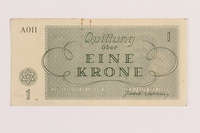
Theresienstadt ghetto-labor camp scrip, 1 krone note, acquired by a Jewish Lithuanian survivor
Object
Scrip, valued at 1 krone, issued in the Theresienstadt (Terezin) ghetto-labor camp and acquired by David Klipp. All currency was confiscated from deportees upon entry and replaced with scrip and ration coupons that could be exchanged only in the camp, located in German occupied Czechoslovakia. David was deported on Janaury 17, 1940, to Łódź Ghetto in Poland from Lithuania. On August 28, 1944, he was transported to Auschwitz concentration camp in Poland. He was on the same transport as Chaim Rumkowski, the head of the Jewish Council. David was then selected for forced labor and sent to Continental-Gummi-Werke, AG factory, a subcamp of Neuengamme. He worked on the upper floors where rubber was cooked. On November 30, he was sent to Ahlem, another Neuengamme subcamp, to work in an old mine. Ahlem was being evacuated on April 6, 1945, when the prisoners were liberated by British and American soldiers. David relocated to Hannover, Germany on December. 11, 1945. He emigrated to the United States in 1950.
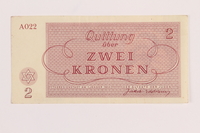
Theresienstadt ghetto-labor camp scrip, 2 kronen note, acquired by a Jewish Lithuanian survivor
Object
Scrip, valued at 2 kronen, issued in the Theresienstadt (Terezin) ghetto-labor camp and acquired by David Klipp. All currency was confiscated from deportees upon entry and replaced with scrip and ration coupons that could be exchanged only in the camp, located in German occupied Czechoslovakia. David was deported on Janaury 17, 1940, to Łódź Ghetto in Poland from Lithuania. On August 28, 1944, he was transported to Auschwitz concentration camp in Poland. He was on the same transport as Chaim Rumkowski, the head of the Jewish Council. David was then selected for forced labor and sent to Continental-Gummi-Werke, AG factory, a subcamp of Neuengamme. He worked on the upper floors where rubber was cooked. On November 30, he was sent to Ahlem, another Neuengamme subcamp, to work in an old mine. Ahlem was being evacuated on April 6, 1945, when the prisoners were liberated by British and American soldiers. David relocated to Hannover, Germany on December. 11, 1945. He emigrated to the United States in 1950.
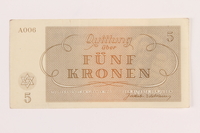
Theresienstadt ghetto-labor camp scrip, 5 kronen note, acquired by a Jewish Lithuanian survivor
Object
Scrip, valued at 5 kronen, issued in the Theresienstadt (Terezin) ghetto-labor camp and acquired by David Klipp. All currency was confiscated from deportees upon entry and replaced with scrip and ration coupons that could be exchanged only in the camp, located in German occupied Czechoslovakia. David was deported on Janaury 17, 1940, to Łódź Ghetto in Poland from Lithuania. On August 28, 1944, he was transported to Auschwitz concentration camp in Poland. He was on the same transport as Chaim Rumkowski, the head of the Jewish Council. David was then selected for forced labor and sent to Continental-Gummi-Werke, AG factory, a subcamp of Neuengamme. He worked on the upper floors where rubber was cooked. On November 30, he was sent to Ahlem, another Neuengamme subcamp, to work in an old mine. Ahlem was being evacuated on April 6, 1945, when the prisoners were liberated by British and American soldiers. David relocated to Hannover, Germany on December. 11, 1945. He emigrated to the United States in 1950.
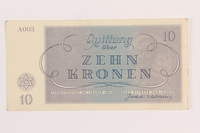
Theresienstadt ghetto-labor camp scrip, 10 kronen note, acquired by a Jewish Lithuanian survivor
Object
Scrip, valued at 10 kronen, issued in the Theresienstadt (Terezin) ghetto-labor camp and acquired by David Klipp. All currency was confiscated from deportees upon entry and replaced with scrip and ration coupons that could be exchanged only in the camp, located in German occupied Czechoslovakia. David was deported on Janaury 17, 1940, to Łódź Ghetto in Poland from Lithuania. On August 28, 1944, he was transported to Auschwitz concentration camp in Poland. He was on the same transport as Chaim Rumkowski, the head of the Jewish Council. David was then selected for forced labor and sent to Continental-Gummi-Werke, AG factory, a subcamp of Neuengamme. He worked on the upper floors where rubber was cooked. On November 30, he was sent to Ahlem, another Neuengamme subcamp, to work in an old mine. Ahlem was being evacuated on April 6, 1945, when the prisoners were liberated by British and American soldiers. David relocated to Hannover, Germany on December. 11, 1945. He emigrated to the United States in 1950.

Theresienstadt ghetto-labor camp scrip, 20 kronen note, acquired by a Jewish Lithuanian survivor
Object
Scrip, valued at 20 kronen, issued in the Theresienstadt (Terezin) ghetto-labor camp and acquired by David Klipp. All currency was confiscated from deportees upon entry and replaced with scrip and ration coupons that could be exchanged only in the camp, located in German occupied Czechoslovakia. David was deported on Janaury 17, 1940, to Łódź Ghetto in Poland from Lithuania. On August 28, 1944, he was transported to Auschwitz concentration camp in Poland. He was on the same transport as Chaim Rumkowski, the head of the Jewish Council. David was then selected for forced labor and sent to Continental-Gummi-Werke, AG factory, a subcamp of Neuengamme. He worked on the upper floors where rubber was cooked. On November 30, he was sent to Ahlem, another Neuengamme subcamp, to work in an old mine. Ahlem was being evacuated on April 6, 1945, when the prisoners were liberated by British and American soldiers. David relocated to Hannover, Germany on December. 11, 1945. He emigrated to the United States in 1950.
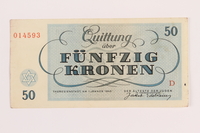
Theresienstadt ghetto-labor camp scrip, 50 kronen note, acquired by a Jewish Lithuanian survivor
Object
Scrip, valued at 50 kronen, issued in the Theresienstadt (Terezin) ghetto-labor camp and acquired by David Klipp. All currency was confiscated from deportees upon entry and replaced with scrip and ration coupons that could be exchanged only in the camp, located in German occupied Czechoslovakia. David was deported on Janaury 17, 1940, to Łódź Ghetto in Poland from Lithuania. On August 28, 1944, he was transported to Auschwitz concentration camp in Poland. He was on the same transport as Chaim Rumkowski, the head of the Jewish Council. David was then selected for forced labor and sent to Continental-Gummi-Werke, AG factory, a subcamp of Neuengamme. He worked on the upper floors where rubber was cooked. On November 30, he was sent to Ahlem, another Neuengamme subcamp, to work in an old mine. Ahlem was being evacuated on April 6, 1945, when the prisoners were liberated by British and American soldiers. David relocated to Hannover, Germany on December. 11, 1945. He emigrated to the United States in 1950.
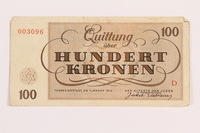
Theresienstadt ghetto-labor camp scrip, 100 kronen note, acquired by a Jewish Lithuanian survivor
Object
Scrip, valued at 100 kronen, issued in the Theresienstadt (Terezin) ghetto-labor camp and acquired by David Klipp. All currency was confiscated from deportees upon entry and replaced with scrip and ration coupons that could be exchanged only in the camp, located in German occupied Czechoslovakia. David was deported on Janaury 17, 1940, to Łódź Ghetto in Poland from Lithuania. On August 28, 1944, he was transported to Auschwitz concentration camp in Poland. He was on the same transport as Chaim Rumkowski, the head of the Jewish Council. David was then selected for forced labor and sent to Continental-Gummi-Werke, AG factory, a subcamp of Neuengamme. He worked on the upper floors where rubber was cooked. On November 30, he was sent to Ahlem, another Neuengamme subcamp, to work in an old mine. Ahlem was being evacuated on April 6, 1945, when the prisoners were liberated by British and American soldiers. David relocated to Hannover, Germany on December. 11, 1945. He emigrated to the United States in 1950.



